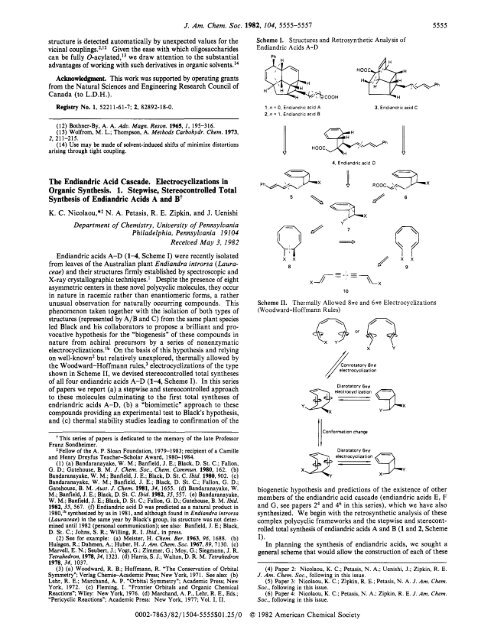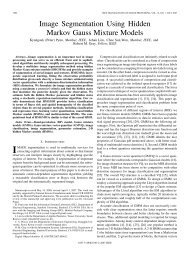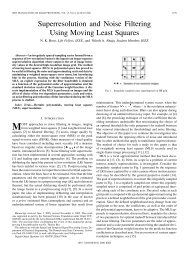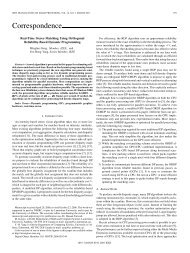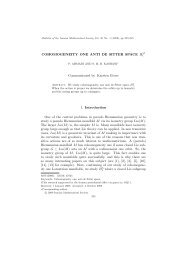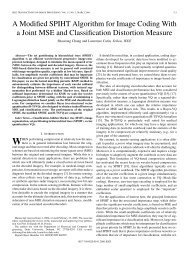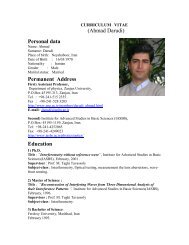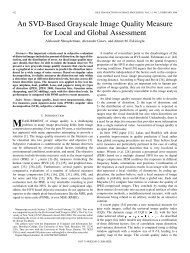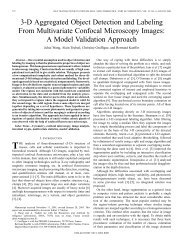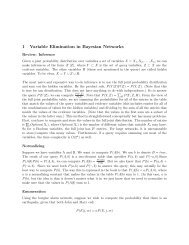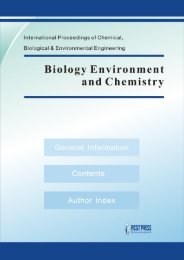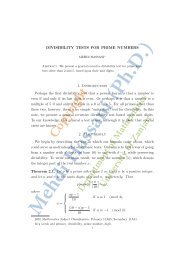The Endiandric Acid Cascade. Electrocyclizations in Organic ...
The Endiandric Acid Cascade. Electrocyclizations in Organic ...
The Endiandric Acid Cascade. Electrocyclizations in Organic ...
Create successful ePaper yourself
Turn your PDF publications into a flip-book with our unique Google optimized e-Paper software.
structure is detected automatically by unexpected values for the<br />
vic<strong>in</strong>al Given the ease with which oligosaccharides<br />
can be fully O-acylated,I3 we draw attention to the substantial<br />
advantages of work<strong>in</strong>g with such derivatives <strong>in</strong> organic ~olvents.’~<br />
Acknowledgment. This work was supported by operat<strong>in</strong>g grants<br />
from the Natural Sciences and Eng<strong>in</strong>eer<strong>in</strong>g Research Council of<br />
Canada (to L.D.H.).<br />
Registry No. 1, 52211-61-7; 2, 82892-18-0.<br />
~ ~ ~ ~~~<br />
(12) Bothner-By, A. A. Ado. Magn. Reson. 1965, I , 195-316.<br />
(13) Wolfrorn, M. L.; Thompson, A. Methods Carbohydr. Chem. 1973,<br />
2, 211-215.<br />
(14) Use may be made of solvent-<strong>in</strong>duced shifts of m<strong>in</strong>imize distortions<br />
aris<strong>in</strong>g through tight coupl<strong>in</strong>g.<br />
<strong>The</strong> <strong>Endiandric</strong> <strong>Acid</strong> <strong>Cascade</strong>. <strong>Electrocyclizations</strong> <strong>in</strong><br />
<strong>Organic</strong> Synthesis. 1. Stepwise, Stereocontrolled Total<br />
Synthesis of <strong>Endiandric</strong> <strong>Acid</strong>s A and Bt<br />
K. C. Nicolaou,*t N. A. Petasis, R. E. Zipk<strong>in</strong>, and J. Uenishi<br />
Department of Chemistry, University of Pennsylvania<br />
Philadelphia, Pennsylvania 19104<br />
Received May 3, 1982<br />
<strong>Endiandric</strong> acids A-D (1-4, Scheme I) were recently isolated<br />
from leaves of the Australian plant Endiandra <strong>in</strong>trorsa (Laura-<br />
ceae) and their structures firmly established by spectroscopic and<br />
X-ray crystallographic techniques. Despite the presence of eight<br />
asymmetric centers <strong>in</strong> these novel polycyclic molecules, they occur<br />
<strong>in</strong> nature <strong>in</strong> racemic rather than enantiomeric forms, a rather<br />
unusual observation for naturally occurr<strong>in</strong>g compounds. This<br />
phenomenon taken together with the isolation of both types of<br />
structures (represented by A/B and C) from the same plant species<br />
led Black and his collaborators to propose a brilliant and pro-<br />
vocative hypothesis for the “biogenesis” of these compounds <strong>in</strong><br />
nature from achiral precursors by a series of nonenzymatic<br />
electrocyclizations.Ib On the basis of this hypothesis and rely<strong>in</strong>g<br />
on well-known* but relatively unexplored, thermally allowed by<br />
the Woodward-Hoffmann rules,3 electrocyclizations of the type<br />
shown <strong>in</strong> Scheme 11, we devised stereocontrolled total syntheses<br />
of all four endiandric acids A-D (1-4, Scheme I). In this series<br />
of papers we report (a) a stepwise and stereocontrolled approach<br />
to these molecules culm<strong>in</strong>at<strong>in</strong>g to the first total syntheses of<br />
endriandric acids A-D, (b) a “biomimetic” approach to these<br />
compounds provid<strong>in</strong>g an experimental test to Black‘s hypothesis,<br />
and (c) thermal stability studies lead<strong>in</strong>g to confirmation of the<br />
This series of papers is dedicated to the memory of the late Professor<br />
Franz Sondheimer.<br />
*Fellow of the A. P. Sloan Foundation, 1979-1983; recipient of a Camille<br />
and Henry Dreyfus Teacher-Scholar Award, 1980-1984.<br />
(1) (a) Bandaranayake, W. M.; Banfield, J. E.; Black, D. St. C.; Fallon,<br />
G. D.; Gatehouse, B. M. J. Chem. SOC., Chem. Commun. 1980, 162. (b)<br />
Bandaranayake, W. M.; Banfield, J. E.; Black, D. St. C. Ibid. 1980, 902. (c)<br />
Bandaranayake, W. M.; Banfield, J. E.; Black, D. St. C.; Fallon, G. D.;<br />
Gatehouse, B. M. Aust. J. Chem. 1981, 34, 1655. (d) Bandaranayake, W.<br />
M.; Banfield, J. E.; Black, D. St. C. Ibid. 1982, 35, 557. (e) Bandaranayake,<br />
W. M.; Banfield, J. E.; Black, D. St. C.; Fallon, G. D.; Gatehouse, B. M. Ibid.<br />
1982, 35, 567. (f) <strong>Endiandric</strong> acid D was predicted as a natural product <strong>in</strong><br />
1980,1b synthesized by us <strong>in</strong> 1981, and although found <strong>in</strong> Endiandra <strong>in</strong>trorsa<br />
(Lauraceae) <strong>in</strong> the same year by Black‘s group, its structure was not deter-<br />
m<strong>in</strong>ed until 1982 (personal communication); see also: Banfield, J. E.; Black,<br />
D. St. C.; Johns, S. R.; Will<strong>in</strong>g, R. I. Ibid., <strong>in</strong> press.<br />
(2) See for example: (a) Meister, H. Chem. Ber. 1963, 96, 1688. (b)<br />
Huisgen, R.; Dahmen, A.; Huber, H. J. Am. Chem. SOC. 1967,89, 7130. (c)<br />
Marvell, E. N.; Seubert, J.; Vogt, G.; Zimmer, G.; Moy, G.; Siegmann, J. R.<br />
Tetrahedron, 1978, 34, 1323. (d) Hams, S. J.; Walton, D. R. M. Tetrahedron<br />
1978, 34, 1037.<br />
(3) (a) Woodward, R. B.; Hoffmann, R. “<strong>The</strong> Conservation of Orbital<br />
Symmetry”; Verlag ChemieAcademic Press; New York, 1971. See also: (b)<br />
Lehr, R. E.; Marchand, A. P. ‘Orbital Symmetry”; Academic Press; New<br />
York, 1972. (c) Flem<strong>in</strong>g, I. ‘Frontier Orbitals and <strong>Organic</strong> Chemical<br />
Reactions”; Wiley: New York, 1976. (d) Marchand, A. P., Lehr, R. E., Eds.;<br />
‘Pericyclic Reactions”; Academic Press: New York, 1977; Vol. I, 11.<br />
J. Am. Chem. SOC. 1982, 104, 5555-5551 5555<br />
0002-1863/82/1504-5555$01.25/0<br />
Scheme I. Structures and Retrosynthetic Analysis of<br />
<strong>Endiandric</strong> <strong>Acid</strong>s A-D<br />
1, n = 0. <strong>Endiandric</strong> acid A<br />
2, n = 1. <strong>Endiandric</strong> acid B<br />
4, <strong>Endiandric</strong> acid D<br />
10<br />
3, <strong>Endiandric</strong> acid C<br />
Scheme 11. <strong>The</strong>rmally Allowed 8ne and 6ne <strong>Electrocyclizations</strong><br />
(Woodward-Hoffmann Rules)<br />
3 9<br />
electrocyclization<br />
Dirrotatory 6ne<br />
-<br />
X Y<br />
Y X<br />
11<br />
II<br />
3<br />
Conformation change<br />
-<br />
3<br />
electrocyclization<br />
Dirrotatory 6ne<br />
X Y<br />
biogenetic hypothesis and predictions of the existence of other<br />
members of the endiandric acid cascade (endiandric acids E, F<br />
and G, see papers 24 and 46 <strong>in</strong> this series), which we have also<br />
synthesized. We beg<strong>in</strong> with the retrosynthetic analysis of these<br />
complex polycyclic frameworks and the stepwise and sterecont-<br />
rolled total synthesis of endiandric acids A and B (1 and 2, Scheme<br />
1). In plann<strong>in</strong>g the synthesis of endiandric acids, we sought a<br />
general scheme that would allow the construction of each of these<br />
(4) Paper 2: Nicolaou, K. C.; Petasis, N. A.; Uenishi, J.; Zipk<strong>in</strong>, R. E.<br />
J. Am. Chem. Soc., follow<strong>in</strong>g <strong>in</strong> this issue.<br />
(5) Paper 3: Nicolaou, K. C.; Zipk<strong>in</strong>, R. E.; Petasis, N. A. J. Am. Chem.<br />
SOC., follow<strong>in</strong>g <strong>in</strong> this issue.<br />
(6) Paper 4: Nicolaou, K. C.; Petasis, N. A,; Zipk<strong>in</strong>, R. E. J. Am. Chem.<br />
SOC., follow<strong>in</strong>g <strong>in</strong> this issue.<br />
0 1982 American Chemical Society
5556 J. Am. Chem. SOC.. Vol. 104, No. 20, 1982 Communications to the Editor<br />
compounds <strong>in</strong> a selective manner from a central <strong>in</strong>termediate and,<br />
as mentioned above, relied heavily on electrocyclic reactions for<br />
stereocontrolled construction of r<strong>in</strong>gs and chiral centers. <strong>The</strong><br />
pr<strong>in</strong>cipal strategic bond disconnections and complete retrosynthetic<br />
analysis of our first, stepwise approach to endiandric acids are<br />
illustrated <strong>in</strong> Scheme I. Thus, disassembl<strong>in</strong>g endiandric acids A<br />
(l), B (2), and C (3) by retro<strong>in</strong>tramolecular r4s + s2s cyclo-<br />
additions (<strong>in</strong>tramolecular Diels-Alder) as <strong>in</strong>dicated leads to<br />
precursors 5 and 6. Disconnections of precursors 5 and 6 at the<br />
marked olef<strong>in</strong>ic bonds by a retro-Wittig-type reaction lead to the<br />
common bicyclic <strong>in</strong>termediate 7 where X and Y are appropriate<br />
appendages to allow for selective buildup of the required side<br />
cha<strong>in</strong>s. Similarly endiandric acid D (4) can be back-traced to<br />
the same key <strong>in</strong>termediate 7 as shown <strong>in</strong> Scheme I. Sequential<br />
open<strong>in</strong>g of the bicyclo[4.2.0] central <strong>in</strong>termediate 7, as <strong>in</strong>dicated,<br />
leads to the cyclooctatriene <strong>in</strong>termediate 8 and thence to the acyclic<br />
tetraene 9. <strong>The</strong> last disconnection arrives at a symmetrical<br />
structure (synthetically a highly desirable feature) with strict<br />
geometrical requirements. F<strong>in</strong>ally, a simple <strong>in</strong>terchange of the<br />
central Z,Z-diene unit with a diacetylenic group<strong>in</strong>g leads to the<br />
<strong>in</strong>termediate 10, the construction of which from readily available<br />
start<strong>in</strong>g materials becomes obvious. <strong>The</strong> three synthetically re-<br />
quired cyclizations are well-known, thermally allowed by the<br />
Woodward-Hoffmann rules3 electrocyclic processes. <strong>The</strong>y are<br />
(i) an 8re conrotatory electrocyclization (Scheme 11), (ii) a 6se<br />
disrotatory electrocyclization (Scheme 11), and (iii) an <strong>in</strong>tramo-<br />
lecular s4s + r2s cycloaddition. This analysis establishes a central<br />
<strong>in</strong>termediate, thus provid<strong>in</strong>g synthetic routes to all endiandric acids<br />
and allows for the exploration of the complete endiandric acid<br />
cascade (Scheme I, paper 3 <strong>in</strong> this series5) and the synthesis of<br />
other stable members of this family of compounds.<br />
In practice the above scheme was realized with remarkable<br />
success both <strong>in</strong> terms of efficiency and stereospecificity. Thus,<br />
when the diacetylenic diol 12 (Scheme 111) (readily available from<br />
trans-pent-2-en-4-yn- 1-01 (1 1) by acetylene coupl<strong>in</strong>g)' was mildly<br />
hydrogenated (L<strong>in</strong>dlar catalyst, CH2C12-CH30H-qu<strong>in</strong>ol<strong>in</strong>e,<br />
90:9.5:0.5, 25 "C, 3-6 h),8 the bicyclic diol 159 was obta<strong>in</strong>ed<br />
directly after column chromatographyI0 (45-55% overall yield).<br />
<strong>The</strong> presumed <strong>in</strong>termediates 13 and 14 (Scheme 111) <strong>in</strong> this<br />
sequence were not detectable under these conditions. Although<br />
direct discrim<strong>in</strong>ation of the two hydroxyls <strong>in</strong> 15 was not possible<br />
even with bulky protect<strong>in</strong>g groups, the two functionalities were<br />
cleanly differentiated by iodo etherification (1.1 equiv of 12, 2.2<br />
equiv of K2CO3, CH2C12, -20 - 0 "C, 2 h) to afford 16 followed<br />
by silylation (1.5 equiv of t-BuPh2SiC1, 3 equiv of imidazole, DMF,<br />
25 "C, 2 h) giv<strong>in</strong>g 17 and reversal of the iodo etherification (3<br />
equiv of Zn dust, AcOH, 25 "C) lead<strong>in</strong>g to the desired 18 <strong>in</strong><br />
70-80% overall yield (from 15). <strong>The</strong> conversion of this mono-<br />
protected diol to the cyanide 20 proceeded uneventfully and <strong>in</strong><br />
95% overall yield (18 - 19: 2.0 equiv of CBr4, 2.0 equiv of Ph3P,<br />
CH2C12, 0 OC.I1 19 - 20 1.5 equiv of NaCN, HMPA, 25 OClZ).<br />
This compound (20) sewed as a key <strong>in</strong>termediate for the stepwise<br />
and stereocontrolled total synthesis of all endiandric acids (A-G).<br />
Reduction of 20 with Dibal (1.1 equiv, CH2C12, -78 "C) followed<br />
by mild acid hydrolysis led to the aldehyde 21, required for the<br />
synthesis of endiandric acids A (1) and B (2).<br />
<strong>The</strong> next operation was to construct stereoselectively a phe-<br />
(7) (a) Haynes, L. J.; Heilbron, I.; Jones, E. R. H.; Sondheimer, F. J.<br />
Chem. Soc. 1947, 1583. (b) Heilbron, I.; Jones, E. R. H.; Sondheimer, F. Ibid.<br />
1947, 1586. (c) truns-Pent-2-en-4-yn-1-01 (11) is commercially available from<br />
Farchan Laboratories, Willoughby, OH.<br />
(8) This L<strong>in</strong>dlar catalyst was supplied to us as a gift from Hoffmann<br />
La-Roche, Inc., Nutley, NJ, courtesy of Dr. John Partridge, and gave superior<br />
results to those obta<strong>in</strong>ed with commercial catalysts.<br />
(9) All new compounds described <strong>in</strong> this and the follow<strong>in</strong>g paperse6 were<br />
characterized by full spectroscopic and analytical or exact mass data. Yields<br />
refer to spectroscopically and chromatographically homogeneous materials.<br />
Complete details will be disclosed <strong>in</strong> a forthcom<strong>in</strong>g full account of this work.<br />
(IO) Still, W. C.; Kahn, M.; Mitra, A. J. Org. Chem. 1978, 43, 2923.<br />
(11) Kocienski, P. J.; Cernigliaro, G.; Feldste<strong>in</strong>, G. J. Org. Chem. 1977,<br />
42, 353.<br />
(12) Shaw, J. E.; Hsia, D. Y.; Parries, G. S.; Sawyers, T. K. J. Org. Chern.<br />
1978, 43, 1017.<br />
Scheme Ill. Total Synthesis of <strong>Endiandric</strong> <strong>Acid</strong>s A (1) and B (2)<br />
HO<br />
7E- 7G-G-<br />
11<br />
14<br />
1 5, X = Y = OH<br />
18. X = OSi'BuPh,. Y = OH<br />
19. X = OSI'BuPh,. Y = Br<br />
20. X = OSi'BuPh,, Y = CN<br />
21. X = OSi'BuPh,, Y = CHO<br />
26 -1<br />
27 -2<br />
22 ~-<br />
HO<br />
I<br />
13<br />
12<br />
n -OR<br />
'\ OH<br />
16. R = H<br />
17. R = SI'BuPh,<br />
Ph<br />
I H<br />
23. X = OSi'BuPh,<br />
24, X = OH<br />
25. X = Br<br />
26, X = CN<br />
27, X = CHO<br />
nyl-substituted E,E-diene group<strong>in</strong>g on the endo side cha<strong>in</strong> of the<br />
molecule <strong>in</strong> order to arrive at the designed precursor for the f<strong>in</strong>al<br />
s4s + r2s <strong>in</strong>tramolecular cyclization. To this end, the anion<br />
derived from diethyl c<strong>in</strong>namylphosphonate (trans-PhCH=<br />
CHCH,P(O)(OEt),) and LDA (2.0 equiv of each, THF, -78 "C,<br />
15 m<strong>in</strong>) was condensed with the aldehyde 21 (-78 - 25 "C, 24<br />
h) to furnish 22 <strong>in</strong> a highly geometrically controlled manner (75%<br />
yield, E:Z I 20:l at the newly formed double bond).13 <strong>The</strong> stage<br />
was now set for the f<strong>in</strong>al and crucial operation to complete the<br />
polycyclic framework of endiandric acids A (1) and B (2).<br />
We were <strong>in</strong>deed delighted to observe an essentially quantitative<br />
conversion of 22 to 2314 at 110 "C (toluene, 5 h), with the <strong>in</strong>dicated<br />
structural assignment proven by eventual conversion to the natural<br />
products (1 and 2) as follows. Desilylation of 23 (1.5 equiv of<br />
n-Bu4NF, THF, 0 - 25 "C) led to 24 (loo%), which was<br />
transformed to the bromide 25 (98%) and thence to the cyanide<br />
26 (98%) as described above (for 18 - 19 - 20). F<strong>in</strong>ally hy-<br />
drolysis of 26 (excess KOH, H202, H20, EtOH, 25 - 50 "C)<br />
proceeded smoothly to afford endiandric acid A (1) <strong>in</strong> 95% yield<br />
identical with authentic material1* <strong>in</strong> all usual respects (IH NMR,<br />
IR, mass spectroscopy, TLC, mp). <strong>The</strong> methyl esters (CH2N2)<br />
(1-methyl ester)14 of the natural and synthetic endiandric acids<br />
A (1) were also identical by these criteria.I4 Reduction (1.1 equiv<br />
of Dibal, CH2C12, -78 "C, then acidic workup) of 26 followed<br />
by condensation of the result<strong>in</strong>g aldehyde 27 with Ph3P=<br />
CHCOOMe (1.5 equiv, benzene, 25 "C, 85% overall yield from<br />
(13) <strong>The</strong> E:Z ratio was determ<strong>in</strong>ed by 'H NMR spectroscopy. It is <strong>in</strong>terest<strong>in</strong>g<br />
to note that while the anion of c<strong>in</strong>namyldiphenylphosph<strong>in</strong>e oxide<br />
(trans-PhCH=CHCH2P(0)Ph2) leads to a similar geometrical result, the<br />
correspond<strong>in</strong>g triphenylphosphorane (trans-PhCH=CHCH=PPh,) results<br />
<strong>in</strong> a 60:40 E:Z mixture.<br />
(14) 'H NMR, IR, and mass spectroscopic data are recorded <strong>in</strong> the supplementary<br />
material.<br />
(15) Authentic natural samples of endiandric acids A (1) and B (2) were<br />
generously supplied to us by Professor D. St. C. Black, Monash University,<br />
Australia.
J. Am. Chem. SOC. 1982, 104, 5557-5558 5557<br />
26)16 furnished endiandric acid B<br />
TosirBup<br />
methyl ester (2-methyl ester)I4 Scheme I. Total Synthesis of <strong>Endiandric</strong> <strong>Acid</strong>s C (1) and D (2)<br />
identical with the methyl ester derived from natural endiandric<br />
acid B (2) (CH2N2) <strong>in</strong> all respects. Alkal<strong>in</strong>e hydrolysis of 2-methyl<br />
NC<br />
ester leads to endiandric acid B (2) (loo%), identical with an - OHC F S i t B u P h 2<br />
authentic ~amp1e.I~<br />
<strong>The</strong>se first total syntheses of endiandric acids A (1) and B (2)<br />
demonstrate the feasibility and power of electrocyclizations both<br />
<strong>in</strong> the laboratory and possibly <strong>in</strong> nature. In the follow<strong>in</strong>g paper<br />
we describe total syntheses of endiandric acids C and D and the<br />
as yet undiscovered endiandric acids E-G."J8<br />
Registry No. (f)-1, 74591-03-0; (f)-1 methyl ester, 74635-24-8;<br />
(f)-2, 76060-33-8; (f)-2 methyl ester, 82730-19-6; (f)-3, 76060-34-9;<br />
(f)-4, 82679-68-3; (E,E)-12, 7199-98-6; (*)-15, 82679-70-7; 16,<br />
82679-71-8; 17, 82706-17-0; (f)-18, 82679-72-9; (*)-19, 82679-73-0;<br />
(f)-20, 82679-74-1; (f)-21, 82679-75-2; (f)-22, 82679-76-3; (f)-23,<br />
82679-77-4; (f)-24, 82679-78-5; (f)-25, 82679-79-6; (f)-26, 82679-<br />
80-9; (f)-27, 82679-69-4; (E)-diethylc<strong>in</strong>namylphosphonate methyl tri-<br />
phenylphoranylidene, 52378-69-5; acetate, 2605-67-6.<br />
Supplementary Material Available: List<strong>in</strong>g of selected physical<br />
properties of key compounds (5 pages). Order<strong>in</strong>g <strong>in</strong>formation<br />
is given on any current masthead page.<br />
(16) A small amount (5-10%) of the cis isomer was formed <strong>in</strong> this reaction<br />
and was chromatographically removed from the desired product. <strong>The</strong> olefi-<br />
nation proceeds just as well (although less convenient) and with higher geo-<br />
metrical selectivity with (MeO)2P(0)CH2COOMe-NaH-THF.<br />
(17) This work was f<strong>in</strong>ancially supported by Merck Sharp & Dohme, the<br />
A. P. Sloan Foundation, and the Camille and Henry Dreyfus Foundation.<br />
(18) <strong>The</strong> work described <strong>in</strong> this and the follow<strong>in</strong>g papers was partially<br />
presented at the 1 lth American Chemical Society Northeast Regional<br />
Meet<strong>in</strong>g, Rochester, NY, October 1981, and the 183rd American Chemical<br />
Society National Meet<strong>in</strong>g, Las Vegas, NV, March-April, 1982.<br />
<strong>The</strong> <strong>Endiandric</strong> <strong>Acid</strong> <strong>Cascade</strong>. <strong>Electrocyclizations</strong> <strong>in</strong><br />
<strong>Organic</strong> Synthesis. 2. Stepwise, Stereocontrolled Total<br />
Synthesis of <strong>Endiandric</strong> <strong>Acid</strong>s C-G<br />
K. C. Nicolaou,*+ N. A. Petasis, J. Uenishi, and R. E. Zipk<strong>in</strong><br />
Department of Chemistry, University of Pennsylvania<br />
Philadelphia, Pennsylvania 19104<br />
Received May 3, 1982<br />
In the preced<strong>in</strong>g communication' we described the total synthesis<br />
of endiandric acids A and B us<strong>in</strong>g electrocyclic reactions<br />
as key steps via a common <strong>in</strong>termediate. Our experimental<br />
f<strong>in</strong>d<strong>in</strong>gs strongly suggested that other members of the endiandric<br />
acid cascade such as endiandric acids E, F (3, 4, Scheme 11) and<br />
G (5, Scheme 111) (see also Scheme I, paper 3 <strong>in</strong> this series2) could<br />
possess enough thermal stability to allow their existence <strong>in</strong> nature.<br />
In anticipation of their discovery <strong>in</strong> Endiandra <strong>in</strong>trorsa (Lauraceae)<br />
and <strong>in</strong> order to aid the search for them, we undertook their<br />
total synthesis. We now detail <strong>in</strong> this paper stepwise and stereocontrolled<br />
total syntheses of endiandric acids C, D (1,2, Scheme<br />
I), E, F (3,4, Scheme 11), and G (5, Scheme 111) from the same<br />
central key <strong>in</strong>termediate 6 (Scheme I) described <strong>in</strong> the preced<strong>in</strong>g<br />
article.'<br />
<strong>The</strong> total syntheses of endiandric acids C (1) and D (2) proceeded<br />
along the l<strong>in</strong>es of the retrosynthetic analysis outl<strong>in</strong>ed <strong>in</strong><br />
the preced<strong>in</strong>g paper' and is depicted <strong>in</strong> Scheme I. <strong>The</strong> aldehyde<br />
7, prepared from 6 as already described,' was condensed with<br />
(MeO2P(O)CH2C0OMe-NaH (1.5 equiv of each, THF, 25 OC)<br />
to afford the a,&unsaturated ester 8 (80% yield),3 sett<strong>in</strong>g the stage<br />
'Fellow of the A. P. Sloan Foundation, 1979-1983; recipient of a Camille<br />
and Henry Dreyfus Teacher-Scholar Award 1980-1984.<br />
(1) Paper 1: Nicolaou, K. C.; Petasis, N. A.; Zipk<strong>in</strong>, R. E.; Uenishi, J.<br />
J. Am. Chem. SOC., preced<strong>in</strong>g paper <strong>in</strong> this issue.<br />
(2) Paper 3: Nicolaou, K. C.; Zipk<strong>in</strong>, R. E.; Petasis, N. A. J. Am. Chem.<br />
SOC., follow<strong>in</strong>g paper <strong>in</strong> this issue.<br />
(3) Small amounts (


